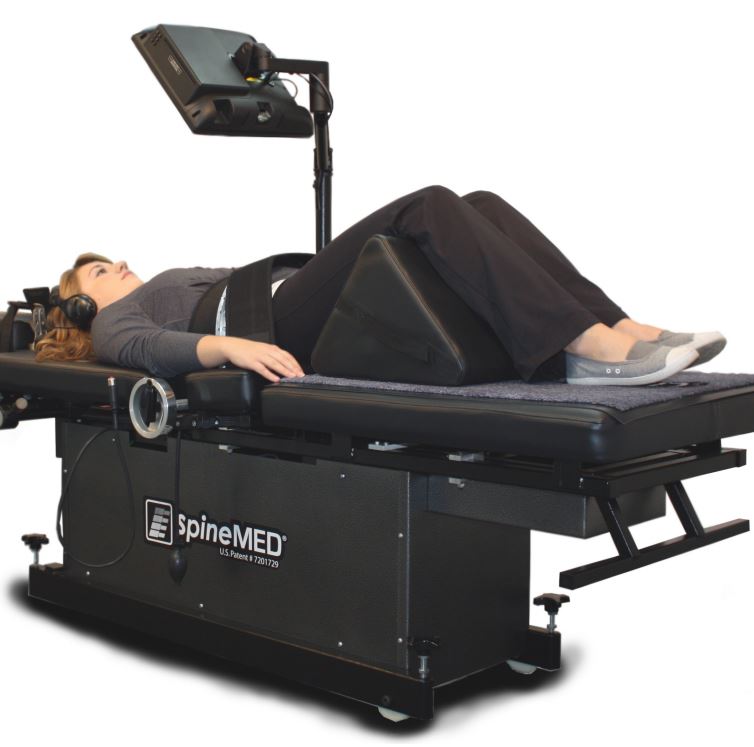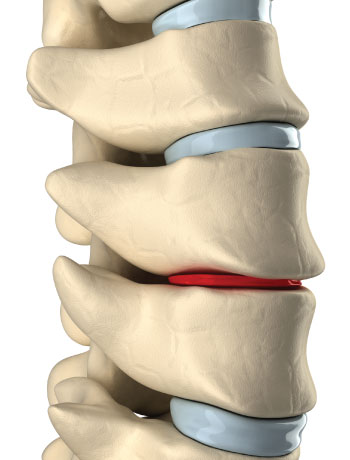Computer-Guided Spinal Decompression System
(Tap or click to scroll to section)
Section 1: Concept of Spinal Decompression
Section 2: Causes of Disc Degeneration
Section 3: How Spinal Decompression works
Section 1: Concept of Spinal Decompression
Spinal discs are subjected to compressive (squeeze) forces every day challenging their strong connective tissue outer wall encasing the disc’s water filled, fibrous interior.
When a disc Bulges, it has suffered damage to its outer connective tissue wall, along with loss of some essential water, resulting from excessive, long-term repetitive compressive forces on it.
The basic concept behind spinal decompression is to draw essential water back into a bulging disc’s interior, and to help heal this outer wall that may have developed stretch weakness and/or cracks.
Treatments are not designed to stretch any aspect of the body, but rather just create a negative pressure on a specific identified bulging/ruptured dis to gently pull water back into its interior like drawing water into a syringe.

This highly advanced technology provides extremely safe but effective therapy treatments in those who suffer from chronic back/neck pain, chronic whiplash injury, and spinal arthritis to name a few.
Caution!
- The spine should never be put into a compromising posture during treatments much like that of an inversion table, decompression technologies that have you lying on your stomach, or pulling with weights and cables.
- Spinal decompression should never be administered on anyone with the pelvis out of its neutral posture, as this will render treatments useless.
Section 2: Causes of Disc Degeneration
Spinal discs are prone to injury and degeneration over the years as they are constantly compressed and twisted as we bend and twist our spine with every daily activity we engage in. Over time, they may lose water content, causing them to bulge, shrink in height, and destabilize the spine. This process can lead to chronic pain, as well as conditions such as disc herniation and nerve compression.
As a disc degenerates, the fibrous water-filled interior loses some of its water, bulging like a car tire that has lost some of its air. It also reduces disc height creating instability to that section in the spine thus causing ligament strain and pain.
Disc degeneration also causes the elastic outer disc lining to become brittle and susceptible to cracks and tears that can lead to disc herniation.
Bulging or herniated discs can then press on exiting spinal nerves, causing severe and in some cases unrelenting nerve pain into arms and/or legs.

Damaged intervertebral discs will not heal if the abnormal forces being exerted on them is not identified and removed, which is the core aspect of what we do at Innovative Therapy Canada.
Our therapy treatment protocols are designed to identify these unwanted forces, remove them, then use the Spinemed decompression system to restore health to the involved discs.
There is a correct time and place for all therapy modalities, and spinal decompression works extremely well at the correct time in a chronic pain treatment plan.
Section 3: How Spinal Decompression works
Once we have corrected any pelvic misalignment issues we are ready to begin spinal decompression.
Lying on your back, the pelvis or neck is rotated forward to position the disc needing treatment to be correctly positioned at the exact angle for traction.
This table rotation is absolutely essential so the traction pressure does not work to decrease your natural spinal curve, but rather work with it at the angle the disc is positioned.
The computer system is set with specifications for the disc to be tractioned, then treatments begin.
Spinemed system treatments take 30 minutes to complete.
- Treatment begins with a 1 minute distraction pressure on the low back or neck targeting a specific disc. The pressure slowly increases over this initial 1 minute session so as to not cause muscle contractions that would negate the treatment.
- The system then relaxes the pressure slightly for 30 seconds, to allow the disc time to absorb the drops of water just pulled into its interior.
- Then the second distraction cycle of 1 minute followed by a 30 second slight release is administered.
- This 1 minute distraction and 30 second pause continues for a total of 20 cycles (30 minutes).
These treatments must be administered 2 or 3 times per week for a total of 10 treatments.
It is impossible for us to predict how many treatments may be required, based on past experience, we offer an initial 10 treatment block to see how the disc’s respond.
When the disc shows signs of responding well to therapy treatments, and more than 40% improvement is noted, then another block of 10 sessions is administered.
If the initial block of 10 treatments has no affect on the disc, we halt treatments as the disc has suffered enough damage to not hold the water drops we are encouraging it to absorb. We are always willing to try to help every disc recover but unfortunately we see discs that have suffered too much damage to be helped with therapy.
Using the car tire analogy, some tires that bulge due to low air pressure can be filled back to normal eliminating the bulge, but some can’t. discs are exactly the same.

